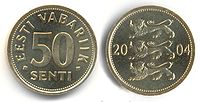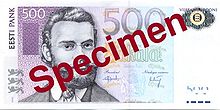|


The kroon (sign: kr; code: EEK) is the currency of Estonia. It is subdivided into 100 senti (singular sent). The word kroon (English: crown) is related to that of other Nordic currencies (such as the Swedish krona and the Danish and Norwegian krone) and derived from the Latin word corona ("crown"). The kroon succeeded the mark in 1928 and was in use until the Soviet invasion in 1940, after which it was replaced by the Soviet ruble. Upon regaining independence in 1992 the kroon was reintroduced. The euro will replace the kroon on 1 January 2011.
History
First kroon, 1928–1940
The kroon became the currency of Estonia on 1 January 1928 after having been a unit of account since 1924. It replaced the mark at a rate of 100 mark = 1 kroon. The kroon was subdivided into 100 senti.
In 1924, the kroon was pegged to the Swedish krona at par, with a gold standard of 2480 kroon = 1 kilogram of pure gold. The standard received real coverage with the reserves backing the kroon. The issue of treasury notes and exchange notes was terminated. In order to secure the credibility of the kroon, Eesti Pank exchanged kroon for foreign currency. All these measures, restored confidence in the domestic banking and monetary sector, contributing to the economic reinvigoration of the country and to the improvement of the reputation of the Estonian state in the international arena.
During the Great Depression in 1933, the kroon went off the gold standard, devaluated 35% and obtained a currency peg with the Great Britain Pound (GBP) at 1 GBP = 18.35 kroon. The Estonian kroon kept this peg and circulated until the Soviet invasion of 1940. The kroon was exchanged for the Soviet ruble at a rate of 1 ruble = 0.8 kroon.
Second kroon, 1992–present
The kroon was reintroduced as Estonia's currency on 20 June 1992, replacing the Soviet ruble at a rate of 1 kroon = 10 rubles. Initially, the Estonian kroon was pegged to the Deutsche Mark at a rate of 8 krooni = 1 Deutsche Mark. After the introduction of the euro the fixed exchange rate of 1.95583 DEM to EUR led to an exchange rate of 15.64664 krooni to the euro. On 27 June 2004, as Estonia joined the ERM II-system, the central parity of the Estonian kroon was revalued (by less than 0.001%) to 15.6466 krooni per euro. As it remains pegged to the euro, it makes no use of its 15% fluctuation band.
Bank Notes and Coins
First kroon
In 1928, the first coins of this currency were issued, nickel-bronze 25 senti pieces. These were followed by bronze 1 sent in 1929, silver 2 krooni in 1930, bronze 5 senti and nickel-bronze 10 senti in 1931, silver 1 kroon in 1933, bronze 2 senti and aluminium-bronze 1 kroon in 1934, nickel-bronze 20 senti in 1935, nickel-bronze 50 senti in 1936.
On 25 July 1940, 4 days after founding of Estonian SSR, the last Estonian pre-WW II coin, new 1 sent (date 1939) was issued.
In 1927, before the kroon was officially introduced, 100 marka banknotes circulated with an "ÜKS KROON" (1 kroon) overprint. Eesti Pank introduced 10 krooni notes in 1928, followed by 5 and 50 krooni in 1929, 20 krooni in 1932 and 100 krooni in 1935.
Second kroon
In 1992, coins were introduced (some dated 1991) in denominations of 5, 10, 20 & 50 senti, as well as 1 kroon. The 1 kroon was struck in cupronickel, the others in aluminum-bronze. However, in 1997, nickel-plated steel 20 senti were introduced, followed by aluminum-bronze 1 kroon in 1998. Coins in circulation:
* 5 senti (1991;1992;1995)
* 10 senti (1991;1992;1994;1996;1997;1998;2002;2006;2008)
* 20 senti (1992;1996;1997;1999;2003;2004;2006;2008)
* 50 senti (1992;2004;2006;2007)
* 1 kroon (1992;1993;1995;1998;2000;2001;2003;2006;2008)
* 5 krooni (1993;1994).
5 senti coins are no longer being issued but are still legal tender. The cupronickel 1 kroon coins from 1992, 1993 & 1995 are no longer legal tender. The 5 krooni coins were commemorative pieces and are rarely seen in circulation.
500 krooni
In 1992, banknotes were introduced in denominations of 1, 2, 5, 10, 25, 100 and 500 krooni. Some of the 5, 10, 25, 100 and 500 krooni notes were dated 1991. In 1994, a 50 krooni note was introduced.
Notes in circulation:
* 1 kroon (1992),
* 2 krooni (1992;2006;2007),
* 5 krooni (1991;1992;1994),
* 10 krooni (1991;1992;1994;2006;2007),
* 25 krooni (1991;1992;2002;2007),
* 50 krooni (1994),
* 100 krooni (1991;1992;1994;1999;2007),
* 500 krooni (1991;1994;1996;2000;2007).
The 1 kroon notes are no longer issued. The 50 krooni notes are not very popular in Estonia and are not seen in everyday circulation very often.
The text on this page has been made available under the Creative Commons Attribution-ShareAlike License and Creative Commons Licenses
| 